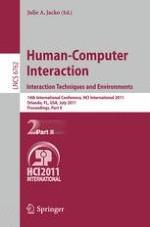This four-volume set LNCS 6761-6764 constitutes the refereed proceedings of the 14th International Conference on Human-Computer Interaction, HCII 2011, held in Orlando, FL, USA in July 2011, jointly with 8 other thematically similar conferences.
The revised papers presented were carefully reviewed and selected from numerous submissions. The papers accepted for presentation thoroughly cover the entire field of Human-Computer Interaction, addressing major advances in knowledge and effective use of computers in a variety of application areas. The papers of this volume are organized in topical sections on touch-based and haptic interaction, gaze and gesture-based interaction, voice, natural language and dialogue, novel interaction techniques and devices, and avatars and embodied interaction.
